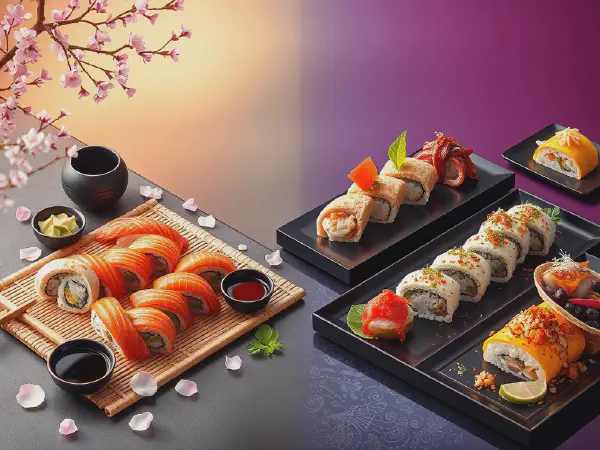Discover Sushi's Journey: Tradition to Modern Delights

The History and Evolution of Sushi
The History and Evolution of Sushi is a fascinating journey that showcases how this simple dish has transformed over centuries. Sushi originated in Southeast Asia as a method of preserving fish in fermented rice. This unique preservation technique eventually made its way to Japan, leading to the creation of sushi as we know it today. The evolution of sushi has been influenced by various cultural shifts, culinary innovations, and the global palate, showcasing the dynamic nature of this beloved dish.
Tracing The History and Evolution of Sushi reveals its roots in ancient preservation methods. Sushi began as 'narezushi,' where fish was salted and wrapped in fermented rice, allowing it to ferment over months. The rice was discarded before consumption, as the focus was firmly on the fish itself. Over time, this technique spread, and each region in Japan adapted it to local tastes and available ingredients, leading to a variety of early sushi forms.
As Japan's culture evolved, so did its food practices, and thus emerged 'suzukuri' which featured fresh fish slices served with rice. This was a significant shift, marking the transition from preservation to flavor. The History and Evolution of Sushi continued to develop with the introduction of 'maki' and 'nigiri' styles, where rice and fish were combined more directly, appealing to a wider audience and representing a more contemporary way of enjoying this dish.
In the late 19th century, sushi underwent another transformation with the rise of Edomae sushi in Tokyo. This version incorporated fresh seafood from Tokyo Bay, and the fast-paced lifestyle of urbanites led to quick service and custom orders in sushi bars. The History and Evolution of Sushi reflects not just a culinary delight but a social phenomenon, as it adapted to a burgeoning urban life while retaining its cultural significance.
Today, The History and Evolution of Sushi encompasses a wide array of styles and flavors, from traditional recipes to modern fusion varieties. As sushi gains popularity globally, the dish continues to evolve, celebrating its heritage while embracing innovation. This transformation ensures that sushi remains a vibrant part of culinary culture around the world.
Origins of Sushi
The origins of sushi can be traced back over a thousand years to ancient Southeast Asia, where it was initially created as a method for preserving fish. The ancient practice involved encasing fish in fermented rice, allowing it to ferment and develop flavors while being preserved. This early sushi form, known as 'narezushi,' provided a reliable food source during times when refrigeration was not an option.
As sushi made its way to Japan, it began to merge with local customs and tastes. In early Japanese culture, the consumption of fish was already prevalent, and the introduction of rice preservation techniques allowed for more diverse culinary options. Sushi became a part of the local diet while gradually evolving to reflect regional preferences and available resources.
Exploring the art of Japanese cuisine, many find that mastering the craft of Sushi requires both precision and passion.
Across Japan, various regions developed their own sushi variations based on the local catch and rice cultivation methods. For instance, the Kansai region is known for its pressed sushi (oshizushi), while the Kanto region favored nigiri sushi, where hand-formed rice was combined with fresh fish. These regional differences laid the groundwork for the diverse sushi styles we have today.
Traditional Sushi Types
One of the most significant traditional types of sushi is nigiri, which consists of a small mound of vinegared rice topped with a slice of fish or seafood. The significance of nigiri sushi lies in its emphasis on the quality of the fish and the skill of the sushi chef. This style of sushi highlights the intricate balance of flavors and represents an artisan craft that has been honed over generations.
Sashimi, the art of serving fresh, sliced raw fish without rice, is another staple of traditional Japanese cuisine. Sashimi's simplicity focuses on the fish itself, showcasing the chef's skill in selecting and preparing quality seafood. It is typically served with wasabi, soy sauce, and garnishes like daikon or shiso to enhance the flavor experience.
Maki sushi, or rolled sushi, has its roots in the Edo period and became a popular way to enjoy sushi. This style involves rolling fish and vegetables in rice, wrapped in seaweed (nori). Maki rolls are often colorful and visually appealing, allowing for creative variations that have made them crowd-pleasers both in Japan and worldwide. The history of maki rolls reflects a shift towards convenience and presentation in sushi dining.
Sushi in Modern Cuisine
In contemporary cuisine, fusion sushi has emerged, blending traditional Japanese ingredients with flavors from around the world. Chefs experiment with various items, creating unique combinations like spicy tuna rolls with sriracha and avocado or using non-traditional ingredients such as cream cheese and mango, appealing to a diverse global audience.
The trends in sushi in the 21st century have included a focus on sustainability, with chefs seeking locally sourced ingredients and traditional practices. There has also been a rise in plant-based sushi, catering to the increasing demand for vegetarian and vegan options. These trends reflect a broader consciousness in society about food sourcing and health.
The influence of international cuisines on sushi is visible in various modern creations, such as the California roll, which introduced avocado and crabstick to the sushi repertoire, making it more accessible to Western palates. As sushi continues to travel across borders, it adapts and evolves, integrating elements from other culinary traditions while retaining its essence.
Cultural Significance of Sushi
Sushi is deeply embedded in Japanese rituals and traditions, often featured in celebrations and special occasions such as weddings and New Year festivities. Sushi is not merely food; it symbolizes unity and community, with the act of sharing sushi representing togetherness and harmony in Japanese culture.
Social aspects of sushi dining involve a unique experience, often emphasizing the communal enjoyment of food. Sushi is frequently enjoyed in groups, whether at a sushi bar or at home, encouraging conversation and interaction among diners. This social element underscores the importance of food in building relationships in Japanese culture.
Globally, sushi has become a symbol of sophistication and culinary artistry. Its perception has transformed from a traditional Japanese dish to a modern gourmet experience enjoyed in various settings, from casual sushi bars to upscale restaurants. Sushi's acceptance and integration into other cultures exemplify its ability to transcend borders and create connections through food.
Sushi Preparation Techniques
Traditional sushi making requires a high level of skill and artistry. Chefs undergo rigorous training to master essential techniques, such as rice preparation, fish selection, and knife skills. The meticulous process of crafting each piece of sushi emphasizes the dedication and respect for ingredients that is central to Japanese culinary philosophy.
The ingredients used in sushi preparation play a crucial role in determining flavor and quality. Sushi rice, a key component, is seasoned with a mixture of vinegar, sugar, and salt to obtain the desired taste. Additionally, fresh seafood, vegetables, and garnishes are carefully selected to complement the rice, showcasing the importance of balance and harmony in sushi making.
Modern innovations in sushi making include advanced techniques and presentations that appeal to the contemporary diner. This includes creative plating, the use of non-traditional ingredients, and unique flavor combinations. These innovations reflect the evolving nature of sushi as chefs continue to experiment and surprise diners while honoring the rich history of this beloved dish.
